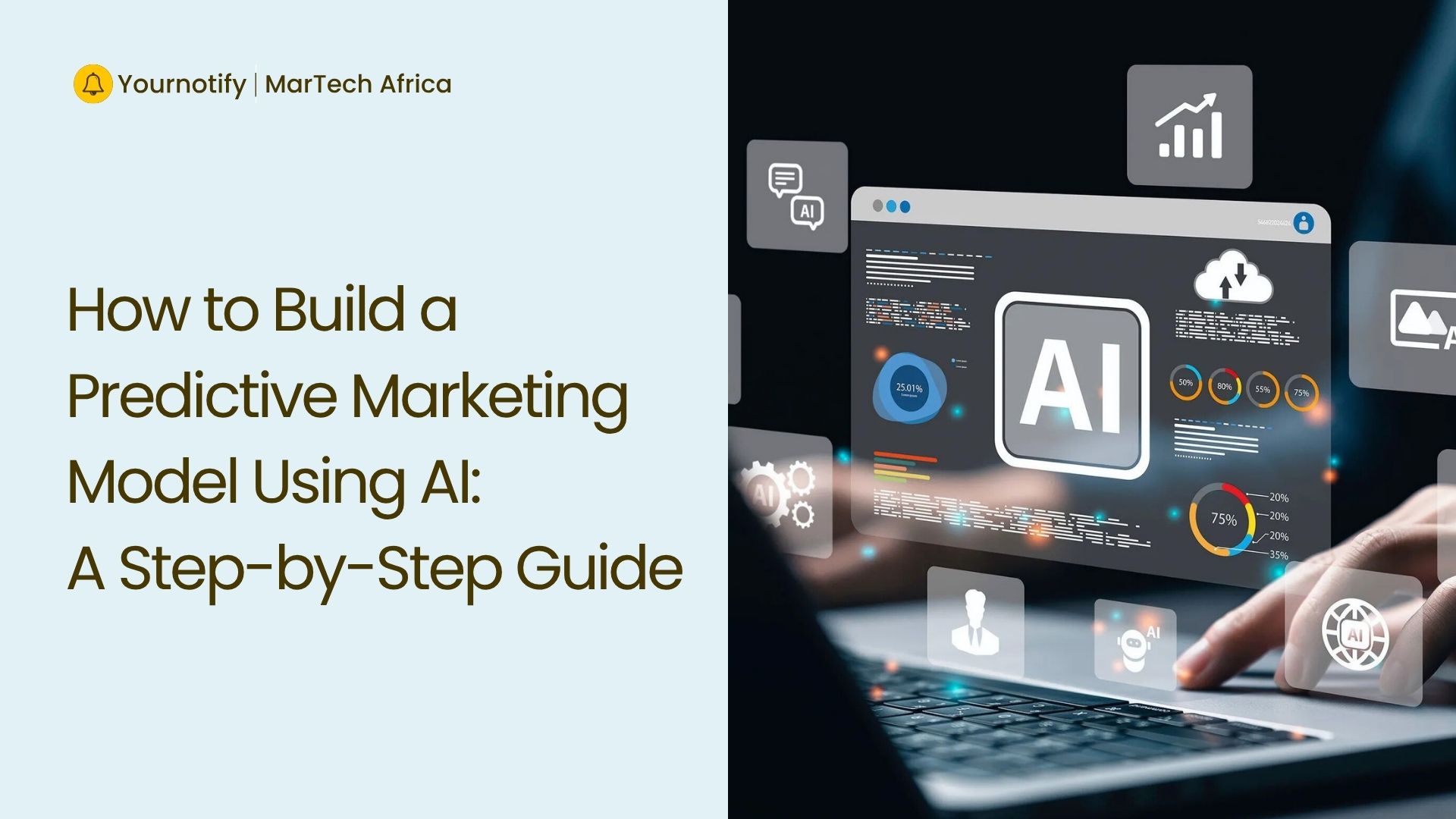When selecting the right Digital Asset Management (DAM) platform, it’s a strategic move that can…

How to Build a Predictive Marketing Model Using AI: A Step-by-Step Guide
In the fast-evolving digital age of 2025, marketers are no longer guessing what customers want, they’re predicting it. Thanks to Artificial Intelligence (AI), businesses now use data-driven insights to anticipate customer behavior and craft hyper-personalized experiences. According to Salesforce’s State of Marketing Report, 84% of marketers say AI helps them better understand customer needs, while McKinsey notes that AI-driven marketing can boost sales productivity by up to 10%.
By leveraging a predictive marketing model, brands can analyze historical customer data like purchase history, engagement patterns, demographics and sentiment to forecast what consumers will do next.
This guide breaks down the key steps to building a predictive marketing model using AI, helping you transform raw data into actionable insights that power smarter campaigns and stronger customer relationships.
What is Predictive Modeling?
Predictive Modeling is a system that is anchored on data access and analytics. It leverages historical data, statistics, Machine Learning, and algorithms. Predictive modeling uses these factors to anticipate future behaviors. It analyses existing data and identifies recurring patterns. These patterns are used to predict future events with high precision. This method is widely used by brands and industries. It is very effective in decision-making and performance optimization.
The Role of AI in Predictive Modeling
AI in marketing has enforced a notable paradigm shift in the modern space. Customer engagement has become more personalized. Predictive Modeling with AI has given room for a wider and well-defined outreach. This is such that brands can now tailor customer behavior to optimum specifications.
AI offers a smooth analysis of a large amount of data. AI marketing tools make use of browsing catalog ad buying patterns to facilitate prediction. Marketers can now anticipate what products, trends, and content will relate most with their audience. Predictive marketing model using AI creates a user-friendly touch in customer engagement. Businesses now go beyond basic demographics to a more psychographic perspective.
Importance of Historical Customer Data
The effectiveness of predictive analytics in marketing anchors on the quality of the historical customer data. This data is very important for the development of AI algorithms. It defines the patterns as behaviors that predict future occurrence. Major sources of such data include CRM systems and email interaction data. Social media demographics, purchase history, and Internet activity are also included.
This data has to be clean and precise. Inconsistencies can lead to faulty algorithms. And this often leads to poor predictions. Reputable customer historical data sets the tone for successful predictive modeling.
How to Build a Predictive Marketing Model
1. State Clear Objectives
It’s important to define the objectives of your predictive marketing model. What specific marketing challenge are you trying to solve? Clearly stating your goals helps guide your data strategy, choice of algorithms, and success metrics.
Start by identifying what you want the model to predict and why. Predictive models can serve different marketing purposes, such as:
-
Lead Scoring: Predict which leads are most likely to convert into paying customers.
-
Customer Retention: Identify customers at risk of churning and take proactive measures to retain them.
-
Personalization: Recommend the right products, content, or offers based on individual behavior patterns.
-
Sales Forecasting: Estimate future sales or demand trends to optimize marketing spend and inventory.
-
Campaign Optimization: Predict which channels or creatives will yield the best ROI before launch.
2. Collect and Prepare Data
A good predictive model thrives on quality data. Engage different sources to gather the relevant data. The data should be fair, diverse, and mirror real-life situations. Employ numerical, text, and image data types.
Focus on accuracy and reliability rather than quantity of data. Diffuse the data into a single data set. This is important for easy analysis and optimization. Missing values and unimportant data should be well handled.
The same goes for duplicates and inconsistent data. Prepare and Process Data. Numerical properties should be normalized. Divide the data into testing and training sets to ensure the model learns effectively.
3. Choose a suitable predictive modeling technique
Selecting the right modeling technique is very important. Certain factors should be considered to achieve accurate predictions for the model. They include the size of data, sophistication, and the manner of prediction. The suitable technique to employ also depends on your set objective. Basically,
- The regression model fits well for numerical outcomes.
- Classification models are a good fit for categorizing customers
- Clustering algorithms are instrumental in identifying customer behavioral patterns
- Neural networks are ideal for analyzing unstructured data
4. Train and Validate the Model
After choosing a technique, train algorithms and develop predictive models. Employ machine learning frameworks like PyTorch to build the model. The concept of training entails inputting the data into the algorithm. This helps it to learn from patterns and occurrences.
5. Deploy and Monitor the Model
After training, the Predictive Model is set for a real-life situation. Deploy it into various aspects of business operations. You can experiment with customer behavior, inventory processes, or risk assessment. Monitor to confirm it is customer-friendly and flexible for decision makers. More so, Performance should be monitored consistently. Especially with the addition of new data. Implement regular retraining and feedback loops for development and stable accuracy.
Practical Applications of Predictive Marketing Model Using AI
Predictive analytics in marketing is actively reshaping businesses and industries globally. It plays major roles in financial institutions, streaming platforms, and E-commerce industries.
Here’s how different sectors are leveraging it:
1. Financial Services
In the financial sector, predictive modeling plays a vital role in fraud detection, credit risk assessment, and customer segmentation. Banks and fintech companies analyze transaction patterns, credit histories, and user behavior to spot anomalies that could indicate fraud.
For instance, American Express uses predictive analytics to detect fraudulent activity within milliseconds, protecting both the company and its customers. It also helps institutions predict which customers are likely to default or close accounts, allowing for timely intervention.
2. E-commerce and Retail
E-commerce giants like Amazon and Shopify use predictive models to recommend products, optimize pricing, and forecast demand. By analyzing browsing history, purchase behavior, and demographic data, these systems predict what customers are most likely to buy next, leading to increased sales and personalized shopping experiences. Predictive models also help retailers manage inventory efficiently, reducing waste and improving supply chain operations.
3. Media and Streaming Platforms
Streaming platforms such as Netflix and Spotify rely heavily on predictive modeling to recommend content based on users’ listening or viewing history. Netflix, for example, reports that over 80% of the content watched on its platform comes from personalized recommendations powered by predictive algorithms. These systems analyze engagement patterns to forecast what users are likely to enjoy next, improving satisfaction and retention.
4. Customer Engagement and Marketing Automation
Marketers use predictive analytics to anticipate customer needs and deliver personalized messages at the right time. For example, predictive email marketing tools can determine when a user is most likely to open an email or make a purchase.
Social media advertisers also use predictive models to determine which audience segments are most likely to engage with a campaign, optimizing ad spend for better ROI.
5. Fraud Detection and Risk Management
Beyond finance, predictive modeling is applied in insurance, telecommunications, and even healthcare to identify high-risk activities or claims. By using machine learning algorithms, these models learn to recognize patterns that signal potential fraud or risk, enabling early detection and prevention.
FAQs
- How long does it take to develop a predictive model?
It depends on the quality of the data, the complexity, and the computing strength. Also, Tuning and testing processes are key factors.
- What is the formula for a predictive model?
There is no exact formula. It depends on the algorithm used.
- How long does it take to train a predictive model?
Training a predictive analytics model may take anywhere from days to months. It depends on the data size, complexity, and hardware involved.
- How to choose the best machine model?
Analyze the data. Check for accuracy, training duration, and real-life applications.
Conclusion
Predictive marketing model is game game-changing tool in business operations. It enables brands to make apt decisions and optimize data operations. The use of AI and customer historical data has produced excellent results. Industries can now predict market trends, mitigate risks, and improve customer engagement. Predictive modeling poses a continuous growth in shaping brand strategies. It promises creativity, efficiency, and profit-making for businesses. For an evolving data-driven world, predictive modeling offers premium success.


